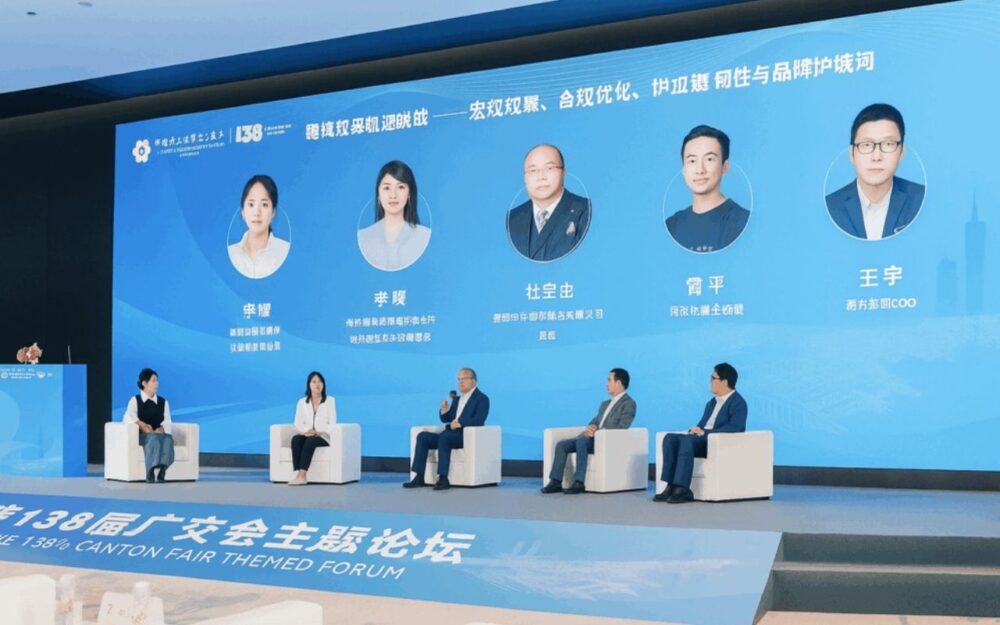As the Canton Fair is in full swing in Guangzhou, Guangdong (China), Erin Tallman, reporting from the ground, explored a key question: how has logistics become the main bottleneck in cross-border e-commerce? She attended a conference where industry professionals discussed how cross-border e-commerce logistics can achieve greater compliance, cost efficiency, and operational optimization, through technology innovation, policy alignment, and new logistics models.
At the 138th Canton Fair the discussion surrounding global trade is less about marketing and more about movement. During phase two of the world’s largest export fair, drawing international buyers and suppliers to Guangzhou, Guangdong province, industry leaders revealed a common pain point for all: logistics has become the bottleneck of cross-border e-commerce.
Global uncertainties, from geopolitical disruptions to tightening customs oversight, have placed unprecedented pressure on delivery networks. The traditional model of multi-supplier sourcing, fragmented data flows, and reactive shipping is no longer sustainable.
At last friday’s “Cross-border E-commerce Ecosystem Innovation and Development” conference, Yang Bochuan of software development company Globex Technology, presented a data-driven roadmap to restore speed and resilience to international trade. His session focused on the transformative role of AI forecasting and data standardization in customs clearance and logistics optimization.
“Compliance is not the opposite of competitiveness,” Yang said. “In the new global environment, compliance is competitiveness. It is the foundation for scale, trust, and operational predictability.”
Read also
Pain Points Identified
Yang began by outlining the systemic weaknesses that continue to slow the cross-border sector. First among them: fragmented data. Inconsistent documentation between suppliers, freight forwarders, and customs authorities remains one of the leading causes of delays and surcharges.
“We still see invoices and product codes that don’t match shipment data,” Yang explained. “That mismatch creates suspicion at the border, even for compliant goods.”
The second structural issue is a lack of predictive visibility. Most logistics chains remain reactive, responding to delays only after they occur. This creates cascading costs in warehouse fees, missed delivery windows, and customer refunds.
“We have the data, but not the integration,” Yang said. “That’s where AI forecasting comes in — to transform guesswork into planning.”
Thirdly, regulatory tightening across markets such as the EU and North America has expanded the definition of risk. It’s not only about delivery delays anymore but also about data integrity, compliance alignment, and environmental impact. The modern logistics manager must juggle customs, carbon, and customer satisfaction simultaneously — an impossible equation without automation.
Solutions Proposed by Globex
Globex Technology’s proposed framework, presented at the fair, revolves around AI-driven forecasting, blockchain verification, and data standardization for customs synchronization.
Using real-time data feeds from partner warehouses and port authorities, Globex’s algorithm predicts clearance times and flags documentation anomalies before shipment. This allows exporters to pre-correct potential compliance issues days before customs inspection.
The second solution involves standardized digital trade documentation. Through partnerships with regional customs systems, Globex integrates a unified digital format that aligns product codes, tariff categories, and origin certificates, reducing the risk of misclassification.
Yang summarized the strategy succinctly:
“We’re not trying to replace the customs process; we’re trying to make it anticipatory rather than reactive.”
In practice, this means turning customs compliance into a predictive science, where data intelligence drives operational decisions, not paperwork.
Read also
The Five Core Models
During the session, Yang outlined what Globex calls the “Five Core Models of Cross-Border Optimization”, each representing a key dimension of efficiency and control.
1/ Predictive Logistics Model (Express / Rapid Consolidation Model)
AI forecasting based on historical route performance and real-time port data. Designed for multi-supplier B2B exporters, this model merges goods in bonded hubs and uses “enter-zone then declare” batch processing. It cuts delivery cycles from a week to about four days while reducing per-shipment costs through centralized documentation and smart consolidation.
2/ Compliance Intelligence Model (1210 Unified Inventory Model)
Automated rule matching for changing customs regulations. The 1210 bonded framework enables a single global inventory. Bulk goods enter bonded warehouses for worldwide fulfillment, improving VAT refund speed, liquidity, and cross-market stock flexibility — “one inventory for the world,” as Yang described it.
3/ Supplier Integration Model (9610 Cloud Warehouse for SMEs)
End-to-end visibility from raw material procurement to last-mile delivery. A light-asset model under the 9610 customs code, it offers simplified declaration and outsourced warehousing for small exporters. Ideal for B2C fulfillment, it lowers fixed costs and accelerates compliant, small-batch cross-border delivery.
4/ Data Standardization Model (Smart Consolidation & Line-Switching Model)
Harmonizing trade documentation under shared taxonomies. This hybrid approach aggregates goods from multiple factories and dynamically switches routes — bulk or parcel — to optimize for time, destination, and cost, turning flexibility into a measurable efficiency tool.
5/ Sustainability and Risk Model (Multi-Model Synergy)
Evaluating carbon impact and regulatory exposure simultaneously. The strategic use of multiple models — 1210 for high-volume SKUs, 9610 for long-tail items, express for urgent shipments — builds agility.
“Compliance routing,” Yang noted, “isn’t a cost; it’s an advantage. These models are designed to make logistics transparent, measurable, and adaptive,” Yang said. “They allow businesses to not only respond to global change but to anticipate it.”
Industry observers at the conference noted that Globex’s models reflect a broader shift across Chinese logistics technology firms — from platform intermediaries to system enablers. Rather than just connecting buyers and sellers, they are now engineering digital trust into the trade process itself.
Quantified Outcomes
To demonstrate tangible impact, Yang presented comparative data from European pilot programs that implemented Globex’s logistics intelligence suite. The most notable example involved a European home goods importer that traditionally required seven days for customs clearance and end delivery. After adopting Globex’s predictive model, the cycle was reduced to three days, with document accuracy rising to 99.2%.
The operational outcome translated into direct financial value: €60,000 saved per shipment on average through reduced warehousing and detention costs. Additional benefits included faster cash flow turnover and a 15% increase in customer satisfaction scores from downstream retailers.
Yang stressed that these results are replicable because they rely on data discipline rather than scale.
“This isn’t about being the biggest exporter,” he said. “It’s about being the most predictable exporter.”
Read also
Improve Reverse Logistics
Another case involved a consumer electronics exporter in Shenzhen facing chronic delays due to inconsistent HS code reporting. Using Globex’s compliance intelligence model, the company achieved a 40% reduction in customs queries and successfully entered two new EU markets within one fiscal year.
A second pilot, conducted with a Southeast Asian fashion supplier, showcased how data harmonization can improve reverse logistics — the often-overlooked side of e-commerce. By tracking return shipments through standardized tags and codes, Globex’s system helped reduce refund cycle time from 12 days to 5.
Such cases highlight an important message for industry professionals: logistics innovation is no longer about faster trucks or bigger ships — it’s about smarter data.
Reaching the Back-end of Trade
As the Canton Fair concluded its final sessions, the logistics discussion underscored a strategic truth: the future of global trade depends on compliance intelligence and data integration, not just physical movement.
While infrastructure investment remains essential, Yang Bochuan’s message to exporters was unmistakable — digital transformation must reach the back-end of trade. Transparency, traceability, and trust are now as critical as price and product.
In Yang’s words:
“Every compliant shipment builds trust. Every trusted shipment builds scale.”
For an industry accustomed to physical challenges, the path forward is increasingly digital — and the Canton Fair’s 2025 logistics dialogue made clear that those who adapt first will move fastest in the decade ahead.
Read also









![Image [Buying Guide] How to Choose the Right Protection Gloves?](/wp-content/uploads/sites/3/Gloves-1-320x213.jpg)
